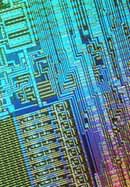
Like silicon, silicon carbide is semiconductor and in some aspects, its characteristics are even better. Electrical strength of silicon carbide is ten times higher than that of silicon, heat conductivity is three times higher. Crystals of silicon carbide are almost perfect for power electronics. They can work at high current density (more than 10 kA per square centimeter) and voltage up to 4.5 kV, unachievable for silicon. Moreover, charge-drift velocity is twice higher in silicon carbide providing b

Carbon nanotubes — tiny tubular structures composed of a single layer of carbon atoms—could lengthen the life of batteries, according to new research. Findings published in the current issue of Physical Review Letters suggest that the diminutive tubes can hold twice as much energy as graphite, the form of carbon currently used as an electrode in many rechargeable lithium batteries.
The reduction and oxidation reactions that occur at the electrodes of batteries produce a flow of electrons t

Hand-held tasting device displays highly discriminating palate.
A new hand-held electronic tongue promises to give accurate and reliable taste measurements for companies currently relying on human tasters for their quality control of wine, tea, coffee, mineral water and other foods.
Human tasters are still irreplaceable for subtile products such as fine wines and whiskies. But their sense of taste saturates after a while, losing its discriminating edge. The device made by An

The tell-tale signature of most lasers used in everyday applications—from bar-code scanners to pen-size pointers—is a bright red glow. The color is determined by the light’s wavelength, and most lasers emit at only one wavelength. Now a new report published in the current issue of the journal Nature describes a light source measuring only tens of millimeters across that changes color according to temperature.
To make the new laser, Diederik Wiersma and Stefano Cavalieri of the European

A new material helps to make clean fuel from water.
Scientists in Japan have found a more efficient way to extract hydrogen, the ultimate ’green’ fuel, from water. They have developed a material that uses sunlight to break water molecules into their constituent elements of hydrogen and oxygen 1 .
The material is not yet efficient enough to be commercially viable, but its inventors believe that it can be improved. If they are right, hydrogen may soon be on tap

Nerve cells soldered to semiconductors cross computing with neuroscience
Scientists in the United States are soldering nerve cells to semiconductors. Christine Schmidt and colleagues from the University of Texas at Austin use a sliver of protein to connect neurons and tiny crystals of semiconductors called quantum dots 1 .
This cross between biology and electronics could have useful applications, including the manufacture of prosthetics operated directly by a

Solar cells printed like wallpaper.
Solar cells might one day be produced by the roll, as cheaply and easily as wallpaper. Scientists in Arizona are using screen-printing, a technique developed for patterning fabrics, to produce plastic solar cells 1 .
The technique is another step towards the general availability of solar power from flexible devices on plastic sheets or glass panels. The basic materials of a photovoltaic cell are inexpensive, but combining t